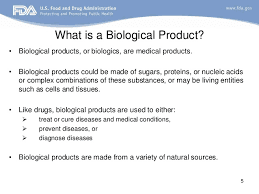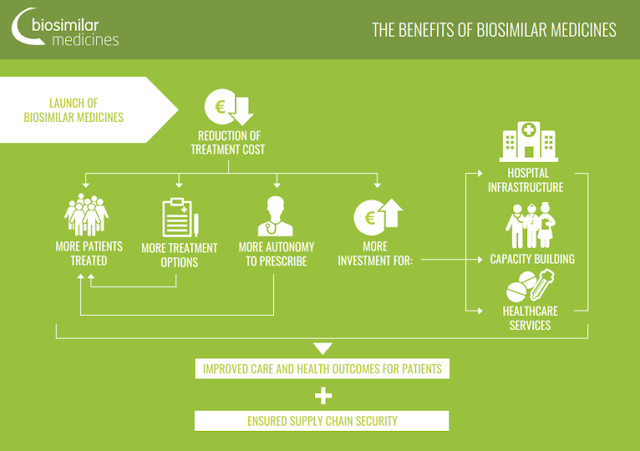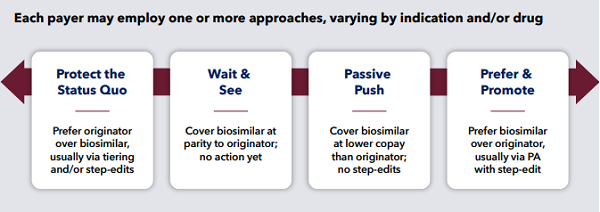What are Biosimilars Biologics Benefits, Challenges and Future?
Biosimilars Advantages, Problems and the Scope
A biosimilar is a biological drug that is highly similar to
an approved biological drug. McKinsey predicts that by 2020, the size of the
biosimilar market will triple, reaching US$1 to US$2 billion. Based on this
alone, we can see that these drugs can change healthcare. A report The
Biosimilar Committee (2018) predicts that biosimilars can save up to 1TP250
billion in costs in the next ten years. Can these products improve the sense of
gain for patients who rely on biological treatments? What are the challenges
and opportunities? This includes the benefits of biosimilars.
A biosimilar is a biological drug that is highly similar to
an approved biological drug. McKinsey predicts that by 2020, the size of the
biosimilar market will triple, reaching US$1 to US$2 billion. Based on this
alone, we can see that these drugs can change healthcare. A report The
Biosimilar Committee (2018) predicts that biosimilars can save up to 1TP250
billion in costs in the next ten years. Can these products improve the sense of
gain for patients who rely on biological treatments? What are the challenges
and opportunities? This includes the benefits of biosimilars.
Table of Contents |
|
What is Biological product?
Biological products are biological molecules derived from living organisms and are used to diagnose, treat and cure many chronic and disabling diseases. These typical large and complex biological molecules-including hormones and monoclonal antibodies-are produced from microorganisms, plants or animal cells using biotechnology.
The natural variability in the host organism leads to variation between the various batches of active biomolecules being produced. Under normal circumstances, these variability are minimal and will not change biological functions.
Today, biological agents provide one of the most cutting-edge technologies for the clinical prognosis of many diseases. The therapeutic potential of these molecules ranges from diabetes to autoimmune diseases to cancer.
Although the
demand for biologics is great, one of its main disadvantages is the high
cost-which is a major obstacle for patients. It is very necessary to understand
the benefits of biosimilars.
What is the Case of Biosimilars?
Consumers’ cost burden seems to be reduced by the second category of biological products, called biosimilars. Biosimilars are biomolecules that are "highly similar to the approved reference biological drugs."
To become a biosimilar, a molecule must It exhibits the same characteristics in terms of "structure, biological activity and efficacy, safety and immunogenicity profile" compared with the original reference molecule. Like biological products, biosimilars are also manufactured biologically. Therefore, this process is a natural change, leading to internal differences from the reference drug. These changes make characterization and regulatory approval a challenging task.
However, if these changes can be proven
not to affect clinical safety and efficacy, biosimilars will be considered for
approval by regulatory agencies.
The reference biological product molecule must pass an "independent" application, containing all data, including clinical trials to prove its safety and effectiveness.
When the patent for an original biological drug expires, other competing companies can apply for marketing authorization for the corresponding biosimilar product.
The ultimate goal of a biosimilar drug development project is to prove "biological similarity" to the reference drug, not to establish an independent safety or effectiveness profile. Therefore, biosimilars do not pass traditional clinical trials, but conduct comparative clinical trials to prove that they are not clinically different from the reference molecule.
Biosimilar molecules can
leverage the safety and efficacy knowledge gathered from years of use of
reference molecules.
From a regulatory perspective, the development of biosimilars does not need to repeat the entire clinical development project like the original reference biologic molecule. This advantage reduces costs for both parties: manufacturers and consumers.
In addition, it saves a large number of volunteers and patients from participating in unnecessary trials. In general, the approval process for biosimilars is more streamlined, simpler, and cheaper than branded original biologics. Therefore, biosimilars enable patients to obtain medical innovations faster and cheaper without compromising efficacy or safety.
A comprehensive list of biosimilars approved by the U.S. Food and Drug
Administration can be found here.
What is the situation regarding Biosimilars in the European Union and the United States?
The European Medicines Agency (EMA) created a special biosimilar approval pathway in the European Union (EU) and approved the first biosimilar (all-rounder 2006). Currently, the European Union is the most mature biosimilar market in the world.
In fact, the EU regulations have set the tone for the development of biosimilars in other parts of the world. As of March 2018, there are more than 40 biosimilars approved by the European Commission.
As the pipeline of biosimilars reviewed by EMA continues to expand, this number is expected to rise further.
In the past decade, the EU medical system has
observed a clear advantage in the competition in the biosimilar market. It is
estimated that by the end of 2018, the EU's biosimilar market will grow to
nearly 1.04 billion U.S. dollars.
In contrast, the biosimilar market in the United States is still quite flat and is slowly emerging with the formulation of regulatory guidelines.
The Food and Drug Administration (FDA) only approved the first biosimilar (Felasim) in 2015. As of July 2018, only 12 FDA-approved biosimilars are on the market.
There is no doubt that the United States is a key biosimilar market. However, many unpredictable factors, including ongoing litigation surrounding patent disputes between innovators, may extend the time to market.
According to RAND data, biosimilars can reduce the cost of biological products
in the U.S. health system by about 1.5 times. $5.4 billion in the next ten
years. Now let us look at the benefits of biosimilars.
What are the The benefits of Biosimilars?
Reduce costs through competition
Biological medicines can be really expensive. For example, a
biological cancer drug may cost hundreds of dollars and thousands of dollars
per patient each year. Having multiple biosimilars on the market will break the
monopoly of reference drugs and help reduce costs.
Improve patient accessibility
With the circulation of more biosimilars, more patients
around the world can obtain these treatment options.
Incentives for innovation
Before the patent for the reference drug expires, the
biosimilar drug cannot be marketed. After the patent expires, having innovative
and patentable new biological products may be a necessary condition for
maintaining a large market share. Therefore, pharmaceutical companies will be
encouraged to invest more in cutting-edge R&D departments to promote
innovation.
What are the Challenges regarding Biosimilars?
Although biosimilars are inexpensive, they face many challenges in seeking acceptance. Some of the current challenges include:
Patient and Prescriber Education
Although biosimilars have existed in the EU for more than a decade, they are still a novelty for people outside of this field. According to a 2014 survey, almost 30% of diagnosed patients said that their drug choice is highly influenced by the identity of the drug manufacturer.
Both the health sector and the pharmaceutical industry need large-scale education.
Prescribers may consider biosimilars to be additional work: reviewing clinical data, discussing alternatives with pharmacists, etc. Whether the insurance company agrees to compulsorily switch to biosimilars makes the situation even more complicated.
Medical society doctors, pharmacists and patients all need to be
inspired and then believe in the benefits of switching to biosimilars.
Inference problem
Extrapolation is "the process of giving a drug clinical indications without the support of its own or new clinical safety and efficacy studies". Whether biosimilars can be used for off-label indications, and these indications are approved for reference drugs, this is a gray area.
Appropriate guidelines must be developed for these indications. Otherwise,
hospitals and pharmacies will be forced to carry reference molecules and
biosimilars at the same time; the cost-effectiveness of prescribing biosimilars
will be wiped out.
Interchangeability issues
Interchangeability refers to whether switching back and forth between two products does not affect efficacy or safety compared with using each product alone.
Although there are some guidelines to determine this, there
are uncertainties at the local prescriber and pharmacy level. Whether
pharmacists can "replace" reference molecules with interchangeable
biosimilars without a clear prescription, or vice versa, is another way to seek
reconciliation.
Rare disease
The treatment of rare diseases often uses "orphan
drugs" associated with high costs. Although biosimilars are being
developed for these orphan drugs, they face many practical obstacles. First, it
is difficult to obtain a large enough, non-heterogeneous population for phase I
and phase III trials. In addition, the cost of manufacturing enough batches of
biosimilars to conduct batch-to-batch variability studies to establish
extensive comparability data may be disproportionately high.
What is the Future of Biologics and Biosimilars?
The biosimilar industry and its regulation have developed by leaps and bounds in the past decade. With some of the most prescribed biologics facing patent expiration in the near future, the biosimilar market is expected to see more growth.
Market competition promoted by biosimilars poses a threat to the monopoly of the brand-name pharmaceutical industry.
Typically, pharmaceutical giants are considered to obstruct biosimilar companies in a network of intellectual property rights.
In the next few years, regulatory
authorities need to provide a more specific framework to address some gray
areas in the marketing and prescription of biosimilars. This, along with
practitioner/consumer education, new development and business models, can lay
the foundation for the creation of new large-scale biosimilars. The following
are the benefits of biosimilars.
What are the developments in Biologics and Biosimilars regarding Psoriasis?
What is the Ec onomic Impact of Biosimilars?
The economic impact of non-medical conversion from original biologics to biosimilars:
Here is a systematic literature review to review and summarize the economic impact of non-biological switch (NMS) from a bio-initiator to its biosimilar (ie, the switch to a patient’s drug for reasons unrelated to the patient’s health).
Methods In the past 10 years and the past 3 years, selected scientific conferences were retrieved from PubMed and EMBASE in English publications reporting healthcare resource utilization (HRU) or costs related to biosimilar NMS, And the gray literature on all approved biosimilar biologics (for example, tumor necrosis factor inhibitors, erythropoiesis, insulin and hormone therapy).
Results: A total of 1,311 publications were retrieved, of which 54 studies met the selection criteria.
Seventeen studies reported that HRU in the real world or increased costs associated with biosimilar NMS, for example, higher surgery rates (11%), steroid use (13%) and increased biosimilar doses (6-35.4 %). In the study of estimated cost impact related to NMS, 33 cases reported reduction in drug cost, 12 cases reported medical expenses after NMS, but no detailed breakdown, and 5 cases reported NMS establishment and management costs.
Cost estimation/simulation studies have shown a reduction in costs associated with NMS. However, due to the heterogeneity of research design and assumptions (for example, disease area, discount rate of drug prices, cost composition, population size, study period, etc.), there are large differences between studies.
Conclusion Real-world research reports indicate that the economic impact of biosimilar NMS exists separately from the cost of the drug. Those who reported this result found that HRU increased in patients with biosimilar NMS. Research on cost estimation is mainly limited to drug prices.
A comprehensive assessment of the economic impact of NMS should incorporate all important elements of medical service demand, such as drug prices, biological discounts, HRU, NMS plan setting, management and monitoring costs. Sponsor AbbVie.
> SHARE this article >>





























